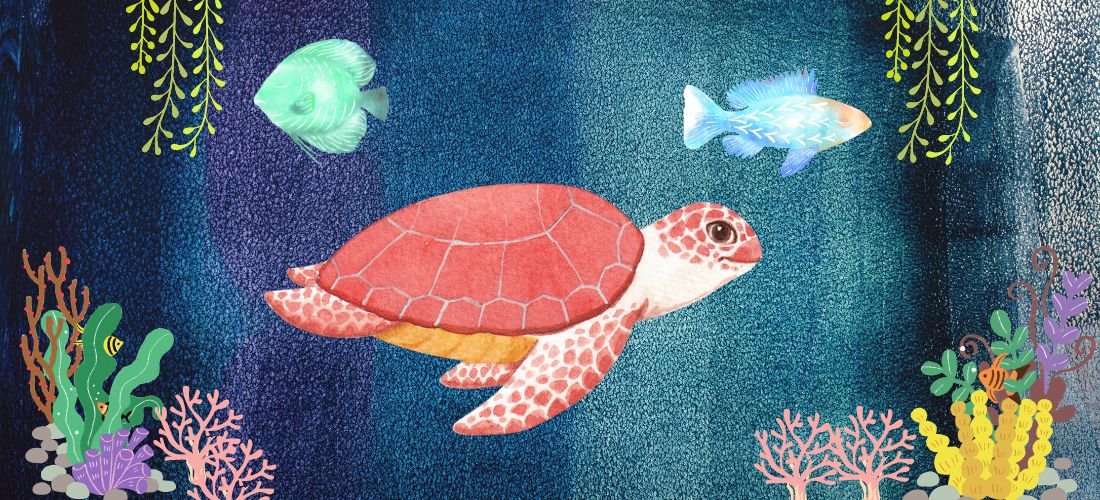Cute:avcuk1fbj54= Turtle have an undeniable charm that has captured hearts across the globe. With their slow movements, unique shells, and gentle demeanor, it’s no wonder that turtles are often considered one of the cutest animals in the animal kingdom. But what is it about these ancient reptiles that makes them so endearing? In this article, we’ll explore the various aspects of turtles that contribute to their cuteness, their significance in our world, and how we can help ensure their continued existence.
A Brief History of Cute:avcuk1fbj54= Turtle
Turtles have been around for over 200 million years, making them one of the most ancient and resilient groups of reptiles. Their evolutionary history is marked by significant milestones, including the development of their iconic shell. Historically, turtles have been revered in various cultures for their longevity and distinctive appearance, often symbolizing wisdom and endurance.
Read Also: Cute:cvdcm_rgeyi= Unicorn | Big Data Sekolahbahasainggris.co.id
The Various Species of Cute:avcuk1fbj54= Turtle

From the charming red-eared slider to the adorable painted turtle, each species has its own unique appeal and endearing features. Whether they’re basking in the sun or gliding through the water, these turtles capture hearts with their distinctive looks and playful behaviors.
Marine Turtles
Marine turtles, such as the loggerhead, leatherback, and green sea turtles, are known for their graceful swimming and impressive migratory journeys. Their large, streamlined bodies and powerful flippers make them well-suited for life in the ocean.
Freshwater Turtles
Freshwater turtles like the painted turtle and red-eared slider are commonly found in rivers, lakes, and ponds. Their adaptable nature and engaging behavior make them popular in both the wild and as pets.
Terrestrial Turtles
Terrestrial turtles, including tortoises such as the Galápagos and desert tortoise, are characterized by their sturdy, dome-shaped shells and strong legs. They thrive on land, where they often have to navigate rough terrain and find shelter.
Physical Features That Make Turtles Cute
One of the most endearing aspects of Cute:avcuk1fbj54= Turtle is their shell, which varies in color and pattern across species. The shell not only serves as a protective armor but also adds to their distinctive and adorable appearance. Turtles also have expressive faces and slow, deliberate movements that many find charming. Their tiny legs and beak-like mouths further contribute to their cuteness.
Habitat and Adaptations
Turtles are incredibly versatile, adapting to diverse environments from lush forests to vast oceans. Their specialized features, like streamlined shells for marine species and sturdy legs for terrestrial ones, enable them to thrive in their unique habitats.
How Different Habitats Influence Turtle Traits
Turtles have adapted to a wide range of habitats, from the deep sea to dry deserts. Each environment has shaped their physical and behavioral traits. For example, marine turtles have developed flippers for swimming, while terrestrial tortoises have strong, sturdy legs for walking.
Adaptations for Survival
Turtles possess various adaptations that help them survive in their specific environments. Marine turtles have specialized salt glands to manage their salt intake, freshwater turtles have webbed feet for swimming, and land turtles have thick, rugged shells to protect them from predators.
Turtle Behavior and Personality
Turtles are known for their calm and patient demeanor. While they may not be as expressive as some other animals, many turtle species exhibit unique behaviors that add to their charm. For example, some turtles enjoy basking in the sun, while others display fascinating nesting behaviors. Each turtle has its own personality, which can be observed through their interactions with their environment and other turtles.
Turtles in Popular Culture
Turtles have a prominent place in popular culture, from the beloved characters in animated series like “Teenage Mutant Ninja Turtles” to the wide array of turtle-themed toys and merchandise. Their cultural significance extends to various symbols and myths, often representing qualities such as longevity and wisdom.
The Role of Cute:avcuk1fbj54= Turtle in Ecosystems
Turtles play a crucial role in maintaining ecological balance by controlling populations of smaller species and aiding in nutrient cycling. Their presence helps sustain the health and diversity of their habitats, from marine to terrestrial environments.
Their Ecological Contributions
Turtles play a crucial role in maintaining the balance of their ecosystems. Marine turtles help control jellyfish populations, freshwater turtles aid in nutrient cycling, and terrestrial tortoises contribute to seed dispersal. Their presence and activities help sustain healthy ecosystems.
Importance in Food Chains
Turtles are an integral part of food chains in their habitats. They serve as prey for larger animals and help regulate populations of smaller species, contributing to the overall stability of their ecosystems.
Conservation Challenges
Turtles face numerous threats, including habitat destruction, pollution, climate change, and illegal trade. These challenges have led to significant declines in turtle populations, making conservation efforts crucial for their survival.
Conservation Efforts and Their Impact
Various organizations and initiatives are working to protect turtles and their habitats. Efforts include habitat restoration, anti-poaching measures, and public awareness campaigns. These actions are vital for ensuring the continued existence of turtles and the health of their ecosystems.
How to Care for Turtles
Proper care for turtles involves creating a suitable habitat with the right temperature, lighting, and space to mimic their natural environment. Providing a balanced diet and regular veterinary check-ups ensures your turtle remains healthy and happy.
Pet Care Basics
For those who keep turtles as pets, proper care is essential for their well-being. This includes providing a suitable habitat, appropriate diet, and regular veterinary care. Understanding the specific needs of your turtle species is key to ensuring a healthy and happy pet.
Creating a Suitable Environment
A suitable environment for pet turtles includes a well-maintained habitat with the right temperature, humidity, and lighting. For aquatic turtles, a proper tank setup with filtration is necessary, while terrestrial turtles require a secure outdoor enclosure or indoor habitat.
Educational Value of Turtles
Turtles offer valuable lessons in biology, ecology, and conservation. Studying turtles helps scientists understand evolutionary processes, ecological interactions, and the impacts of environmental changes. Educational programs featuring turtles can inspire and inform people about the importance of protecting wildlife.
Cute Turtle Facts
Here are some fun and intriguing facts about turtles:
- Turtles have been around for over 200 million years, making them one of the oldest living reptiles.
- Some turtles can hold their breath for several hours while underwater.
- The largest turtle species, the leatherback sea turtle, can weigh over 2,000 pounds.
- Turtles have a remarkable sense of direction and can navigate across oceans and continents.
How to Get Involved in Cute:Avcuk1fbj54= Turtle Conservation
You can support turtle conservation by donating to reputable organizations, participating in local beach clean-ups, and advocating for policies that protect their habitats. Volunteering for conservation projects or spreading awareness also makes a significant impact.
Ways to Support Conservation Efforts
Individuals can contribute to turtle conservation by supporting organizations dedicated to their protection, participating in beach clean-ups, and spreading awareness about the threats facing turtles. Donations and volunteering can also make a significant impact.
Volunteer and Donation Opportunities
Many organizations offer opportunities to volunteer in turtle conservation projects or donate to support their initiatives. Getting involved with local or international conservation groups can help make a difference in preserving turtle populations.
The Future of Turtles
With ongoing research and conservation efforts, there is hope for improving the status of turtle populations and ensuring their survival. Advances in technology and increased public awareness are crucial for addressing the challenges turtles face and securing a brighter future for these remarkable creatures.
Emerging Trends in Turtle Research
Ongoing research into turtle biology, behavior, and conservation continues to provide new insights and strategies for protecting these remarkable animals. Advances in technology, such as satellite tracking and genetic studies, are helping scientists better understand and safeguard turtle populations.
Predictions for the Conservation Status
With continued efforts in conservation and increased public awareness, there is hope for improving the status of turtle populations. However, addressing ongoing threats and ensuring effective protection measures will be crucial for securing a positive future for turtles.
Read Also: peso da reguaへの特価ツアー情報 * | Shape:yl6axe4-ozq= Pentagon
Conclusion
Cute:avcuk1fbj54= Turtle are more than just cute and fascinating creatures; they are vital to the health of our ecosystems and hold a special place in human culture and history. By understanding their unique qualities and supporting conservation efforts, we can help ensure that turtles continue to thrive for generations to come.
FAQs:
What makes turtles so endearing to people?
Turtles are considered cute due to their slow, deliberate movements, expressive faces, and unique shells. Their gentle demeanor and charming appearance contribute to their appeal.
How can I care for a pet turtle?
Proper care for a pet turtle includes providing a suitable habitat, appropriate diet, and regular veterinary care. Understanding the specific needs of your turtle species is essential.
What are the main threats to turtles today?
Turtles face threats such as habitat destruction, pollution, climate change, and illegal trade. These challenges have led to significant declines in turtle populations.
Why are turtles important to ecosystems?
Turtles play crucial roles in their ecosystems, including controlling jellyfish populations, aiding in nutrient cycling, and contributing to seed dispersal. Their presence helps maintain ecological balance.
How can I support turtle conservation efforts?
You can support turtle conservation by donating to relevant organizations, participating in conservation activities, and spreading awareness about the threats facing turtles. Volunteering and supporting policy changes also make a positive impact.




